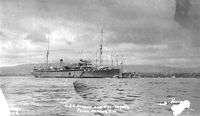USS Dobbin (AD-3)
_in_the_1940s.jpg) | |
| History | |
|---|---|
| Builder: | Philadelphia Navy Yard |
| Laid down: | 16 December 1932 |
| Launched: | 5 May 1921 |
| Sponsored by: | Mrs. H. H. James |
| Commissioned: | 23 July 1924 |
| Decommissioned: | 27 September 1946 |
| Honours and awards: | 1 × battle star |
| Fate: | Transferred to the United States Maritime Commission for disposal |
| General characteristics | |
| Type: | Destroyer tender |
| Displacement: | 12,450 long tons (12,650 t) full load |
| Length: | 483 ft 10 in (147.47 m) |
| Beam: | 61 ft (19 m) |
| Draft: | 24 ft 1 in (7.34 m) |
| Propulsion: | Parsons geared turbines |
| Speed: | 16 knots (30 km/h; 18 mph) |
| Armament: | 4 × single 5"/38 caliber guns |
USS Dobbin (AD-3) is the name of a United States Navy destroyer tender of World War II, named after James Cochrane Dobbin, the Secretary of the Navy from 1853 to 1857.
Dobbin was launched on 5 May 1921 by the Philadelphia Navy Yard. She was commissioned on 23 July 1924, and served for 22 years before being decommissioned on 27 September 1946, and transferred to the United States Maritime Commission for disposal.
Missing captain
In July 1941 Commander Thomas C. Latimore, Dobbin's captain, disappeared while hiking the local Aiea Hills. His body was never found and was the subject of much local news coverage and rumor before being overshadowed by the Pearl Harbor attack.
Attack on Pearl Harbor

Dobbin was present during the attack on Pearl Harbor on 7 December 1941. At the time of the attack she was moored northeast of Ford Island with five destroyers, USS Phelps (DD-360), USS Macdonough (DD-351), USS Worden (DD-352), USS Dewey (DD-349) and USS Hull (DD-350).[1]
Dobbin's watched helplessly as Japanese planes targeted Battleship Row, but as the battleships each took heavy damage the Japanese pilots looked for other targets. The aircraft seeing that the ship had admiral flags[1] tried to bomb Dobbin but the ship only took shrapnel damage.
Dobbin's small craft spent the morning picking up survivors and taking the wounded to shore. The ship picked up hundreds of sailors from other ships and when she left the harbor in search of the Japanese fleet had 200 men from USS Raleigh (CL-7) alone aboard.[1]
World War II
After the attack, Dobbin served in the Hawaiian area until May 1942 and then she was sent to Sydney, Australia. Dobbin was one of several Allied vessels located in Sydney Harbor during the Japanese midget submarine attack of 31 May 1942.[2] On 25 June 1943 she was sent to Brisbane, Mackay, Townsville, and Cleveland Bay, Australia, before arriving at Milne Bay, New Guinea, 30 September 1943. She stayed near New Guinea until 14 February 1945 at which point she returned to America and decommissioned 27 September 1946, and transferred to the Maritime Commission for disposal 24 December 1946.
Dobbin received one battle star for World War II service.
See also
References
- 1 2 3 La Forte, Robert S.; Marcello, Ronald E. (2001) [1992]. "Maps". Remembering Pearl Harbor: Eyewitness Accounts by U.S. Military Men and Women (Paperback). New York: Ballantine Books. p. 314. ISBN 978-0-345-37380-9.
- ↑ Jenkins, David (1992). Battle Surface! Japan's Submarine War Against Australia 1942–44. Milsons Point: Random House Australia. pp. 193–194. ISBN 0-09-182638-1.
This article incorporates text from the public domain Dictionary of American Naval Fighting Ships. The entry can be found here.
| ||||||||||||||